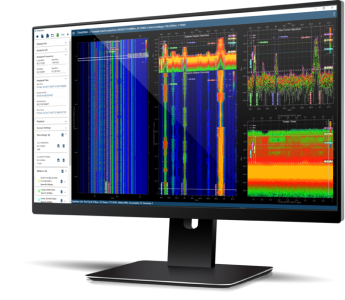
Take a picture with a low-quality camera, and you will get a low-quality result. This might be fine for a family photo, but for intelligence-gathering purposes, using low-tech equipment can have far-reaching consequences.
The same is true with radio frequency (RF) recording equipment. Using a low-fidelity RF recording system will seriously limit the spectrum analyzer’s ability to understand and respond to the complex and dynamic electromagnetic (EM) environment. Conversely, high-fidelity RF recording provides the best way for organizations across military, commercial, and test/lab applications to understand and exploit the EM fully. High-fidelity recording allows users to find weak signals and conduct deep analysis.

Low-fidelity vs. high-fidelity
Low-fidelity recording has a lower number of bits used to represent the signal amplitude, which can result in a loss of signal quality and accuracy. Typically, a low bit depth recording has a bit depth of 8 bits or lower.
However, high-fidelity refers to accurately capturing and reproducing a signal without significant information loss. A high-quality RF recording may have a bit depth of 12 bits or higher, allowing for a much finer resolution of the signal amplitude and a more accurate representation of the signal.
Generally, high-fidelity RF recording is the process of capturing and storing radio signals at a very high resolution and with very low noise or distortion; it is characterized by a high signal-to-noise ratio and high dynamic range. Moreover, to ensure an accurate representation of the original signal, a high-quality antenna must be used to capture a stronger signal with less noise and distortion.
Key considerations about high-fidelity RF recording
Using all the available resolution
While high-fidelity recording captures finer resolution, limitations in a system’s hardware and software can impact the ability to use all the available resolution. For example, some RF systems may have restricted processing power and memory, which limits the amount of data that can be processed and stored.
Using all the available resolution in an RF system is also dependent on factors such as the quality of the signal and the level of interference. By optimizing the system's design, it is possible to make the most of the available resolution—which is more fundamental than having resolution that cannot be used.
A higher sampling rate is advantageous
When an analog signal is sampled, it is converted into a digital signal—the number of signals taken per second is called the sampling rate. A high sampling rates allow a more accurate representation of the original analog signal because the more samples there are, the more accurately the digital representation can capture the shape and characteristics of the original signal.
A higher sampling rate also allows higher-frequency components of the signal to be captured as the highest frequency component that can be accurately represented in a digital signal is half the sampling rate. Therefore, a higher sampling rate allows for the capture of higher-frequency components of the signal that would otherwise be lost or distorted.
However, high sampling rates require more storage space and processing power. Therefore, the optimal sampling rate for RF recording depends on the specific requirements of the application, and it is typically a balance between the desired frequency resolution, storage requirements, and processing capabilities of the recording system.
Choosing a higher ENOB
ENOB (effective number of bits) measures the performance of an analog-to-digital converter (ADC). It is the number of bits of resolution achieved by the ADC, considering factors such as noise, distortion, and linearity.
A higher ENOB means the ADC can accurately resolve small changes in the signal, leading to a more accurate and detailed representation of the original signal. The higher the ENOB, the higher the level of detail that can be captured in the signal.
In practice, a high sampling rate and a high ENOB combined will produce the best quality results.
What can high-fidelity RF recording be used for?
High-fidelity RF recording enables detailed analysis of complex or highly dynamic RF signals, where small variations in signal amplitude may carry important information. And there will be no loss in signal resolution, which is essential on many different levels.
Troubleshooting and diagnostics: It can be difficult to diagnose problems or identify sources of interference in complex RF systems, such as wireless networks or radar systems. However, high-fidelity RF recording allows engineers and technicians to capture and analyze signals in detail, which can help identify issues and improve system performance.
Signal processing and algorithm development: Many RF systems rely on sophisticated signal processing algorithms, such as demodulation, decoding, and filtering. High-fidelity RF recording provides a way to test and develop these algorithms in a controlled environment, which can lead to improved system performance.
Signal intelligence: High-fidelity RF recording can be used to intercept and analyze communications signals for intelligence purposes. By capturing and analyzing the signals, analysts can gain insights into the content and structure of the communications, which can be useful in law enforcement, national security, and other applications.
Proving non-compliance: Certain industries have strict regulations regarding RF emissions and interference. If signals are found in places where there is no license, high-fidelity RF recording could be used to record a breach, which may then be investigated by a regulatory agency.
What applications can benefit from high-fidelity RF recording?
Many applications can benefit from recording high-fidelity RF for long periods of time and then digitizing, storing, and replaying it.
Wireless communications – can benefit from high-fidelity RF recording while developing new devices to ensure correct operation or to test systems against real-world RF environments to provide immunity against signal interference.
Spectrum monitoring – can benefit from high-fidelity RF recording as, by capturing and analyzing real-world RF data, researchers and engineers can gain insights into the performance and behavior of different RF devices, services, and protocols.
RF interference analysis – can benefit from high-fidelity RF recording because it provides a detailed and accurate record of the RF spectrum over time, allowing analysts to identify, locate, and mitigate interference more effectively.
Signal hunting – can benefit from high-fidelity RF recording because it provides a detailed and accurate record of the RF spectrum that can be analyzed to identify and locate signals more effectively.
Radar – can benefit from high-fidelity RF recording because it can capture and store the full bandwidth of radar signals, including any interference or noise that may be present.
Product testing – can benefit from high-fidelity RF recording as it provides a comprehensive and detailed view of the RF environment in which a product is operating. This can be valuable for testing the performance and functionality of wireless devices and systems, as it allows analysts to identify and measure the impact of different types of interference, noise, and other RF-related factors on the product under test.
RF system design – can benefit from high-fidelity RF recording as it provides a detailed and accurate record of the RF environment in which the system will operate, which is valuable for designing and optimizing the system’s performance and functionality.
Electronic warfare – can benefit from high-fidelity RF recording as the entire electromagnetic spectrum is captured, including any weak or intermittent signals.
Example: how a COMINT analyst can benefit from high-fidelity recording
A COMINT analyst has intercepted communications between two individuals who may pose a threat to national security. They are tasked with analyzing a demodulated RF recording of a cell phone conversation to understand the nature of the conversation, establish the relationship between the two people, and gain significant insights into their plans.
However, the analyst has a low-fidelity recording. The audio quality is poor: there is background noise, signal distortion, and static. This recording significantly hinders the analyst’s ability to extract relevant information from the conversation. As intelligence, it is unusable, and law enforcement must look to other sources to gain insights into the suspects' activities.
However, with a high-fidelity RF recording, the analyst will have a more accurate and complete representation of the original conversation, making it easier to extract relevant information. They will have actionable intelligence. High-fidelity RF recordings even capture environmental data, such as whether an individual is in a vehicle or if they are around people speaking foreign languages.
High-fidelity systems need large storage space
Many spectrum analyzers suffer from “front end” compromises, and their RF recorders have only a small amount of internal storage. These limitations mean the equipment is not suited to recording long periods of RF, and it cannot cope with 9 kHz to 40 GHz—and up to 100 MHz IBW. This RF recording equipment will limit spectrum analyzers’ ability to precisely monitor the spectrum, gain full spectrum situational awareness, or assist with Signals intelligence (SIGINT).
To record and store vast amounts of data over a period of many hours, high-fidelity RF recorders require huge storage space (above 20TB). This allows them to record and store data from multiple sources or over long periods, providing greater flexibility in data analysis. The stored data can be replayed and analyzed, allowing for comparisons across different time periods or multiple data sets.
Gaining insights into patterns of light
If RF recorders have large storage space, high-fidelity RF recorders can also help spectrum analyzers gain more comprehensive insights into signal behavior by identifying long-term trends, patterns, and anomalies. Recognizing patterns may help spectrum analyzers go on to find a tiny signal of interest (SOI) in a huge pool of data as they know what triggered an event.
And when an SOI has been identified, instead of continuing to record vast amounts of data, RF recorders that use intelligent triggering systems can use masks to focus solely on and capture the SOI.
Additional benefits of high-fidelity RF systems with large storage
- High-fidelity RF recorders can capture signals with high accuracy and precision, allowing for a more accurate analysis of the signal's characteristics. This improved accuracy and precision can be critical in applications such as signal intelligence, where identifying and decoding signals accurately is essential. This is especially important as EM signals are often easy to hide or disguise.
- High-fidelity RF recorders capture signals with minimal distortion or degradation, preserving the original signal’s quality. This feature is especially useful when analyzing complex signals or when the signals contain critical information that needs to be accurately captured and analyzed.
- High-fidelity RF recorders with large storage capacity can reduce costs. The more data that can be stored, the less frequent downtime and fewer data transfers mean a reduction in operational costs and improved system availability.
The right hardware-software combination
Organizations need to have an appropriate mix of hardware and software to fully understand and respond to the complex and dynamic electromagnetic (EM) environment. Of course, ‘the right’ RF recording tools depend on the application for which they are used. However, the most accurate and precise results will be yielded by high-fidelity recorders with a wide frequency range, a high dynamic range, and a large storage capacity.
Another important consideration is for the data-capturing hardware to use a standard format such as VITA 49. Capturing it in a proprietary format is not useful as it will be incompatible with third-party software.
Accompanying software should enable users to gain insights and make informed decisions based on complex and detailed RF data. It must be able to handle large datasets, real-time analysis capabilities, and customizable visualizations. It should also allow modern signal hunting, replay signals recorded in real-world environments, analyze radar signals, and provide 24/7 spectrum monitoring.
Together, the hardware and software should work seamlessly together to provide a reliable capture-record-data visualization analysis flow.
- The signal is captured by the RF receiver
- The RF recording is stored (I/Q Block, I/Q streaming and storage)
- The stored recording is analyzed (including real-time processing)
Conclusion – the value of high-fidelity recording
High-fidelity RF recording has a wide range of applications and offers numerous benefits. By capturing RF signals with high accuracy and precision, high-fidelity recording enables detailed analysis and processing of the signal, leading to more accurate and informed decision-making.
High-fidelity recording can be particularly valuable in applications such as spectrum monitoring, signal intelligence, and electronic warfare, where accurate and detailed information is critical. With the development of new technologies and tools, such as portable high-fidelity RF recorders and advanced software analysis tools, high-fidelity RF recording is becoming more accessible and practical for a wider range of applications.
Jaimie Brzezinski
Jaimie Brzezinski is Head of Content for CRFS. His specialty is turning highly technical ideas into engaging narratives. He has 15+ years of experience in writing technical content and building global teams of subject matter experts.



